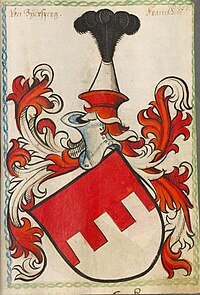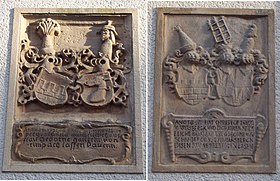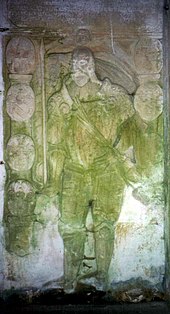Wirsberg (noble family)

The von Wirsberg family is an old Franconian noble family .
history

The origin and headquarters of Lanzendorf
At the end of the 12th century, the Dukes of Andechs-Meranien acquired the Walpotic property around Trebgast , Berneck and Marktleugast . Where the valley cuts of the Schorgast and especially the Kosser allowed the ascent to the Franconian forest plateau , the Andechs-Meranians had a castle built by their ministerial offices, the name of which appeared for the first time in 1234 as "Wirtesperc". An "Eberhard hospes" first mentioned in 1203 appeared four years later as the Andechs-Meranischer Ministeriale. His nickname "hospes", the Latin word for host, makes him appear as the likely founder of Wirsberg Castle and as the progenitor of the family of the same name. Together with the Förtsch von Thurnau and the Lords von Wallenrode , the Wirsbergers can be traced back to an "Eberhard de Briscwizze" ( Oberpreuschwitz near Bayreuth ) named in the Giechburg Treaty in 1149 .
The castle Wirsberg was never in equity or feudal property named after her ministerials family. Rather, after the death of the last Andechs-Meranier in 1248 - together with the lordship of Plassenberg - it passed into the possession of the Counts of Orlamünde and from these in 1340 it passed to the Hohenzollern burgraves of Nuremberg . The Lanzendorf Castle is to be regarded as the headquarters of the Wirsbergers . In 1303 Heinrich von Wirsberg received the patronage of the Lanzendorfer Church as a fief from the Würzburg bishop . According to a Henneberg fiefdom from 1317, the Wirsbergers had numerous tithe fiefs , including those in Lanzendorf, Marktschorgast , Grafendobrach , Goldkronach and Gesees , which had come to the Counts of Henneberg from the inheritance of the Andechs-Meranians . In 1339 the brothers Eiring and Konrad von Wirsberg appeared as "sat in Lanzendorf". Lanzendorf remained in the hands of the Wirsbergers until the family died out with the death of Philipp Christian von Wirsberg in 1687 (April 10th).
Distribution in what is now Upper Franconia
With the growing importance of the family, their property gradually expanded beyond the limits of their original field of activity. Eduard Margerie, who dealt intensively with the history of the Wirsbergers, compiled more than 300 places in which the Lords of Wirsberg owned or where they were employed as stately officials in thirty years of activity. In addition to Wirsberg and Lanzendorf, the most important places in what is now Upper Franconia include:

Glassworks
In 1426 Margrave Friedrich I of Brandenburg awarded the Glashütten estate to the knight Friedrich von Wirsberg and his son Albrecht. Around fifty years later Soldan was accused by Wirsberg of having given a robber called "Reithans" and his cronies shelter in glassworks. In 1472 the Bayreuth knight captain Appel von Lichtenstein captured the Glashütten Castle. In 1476 Soldan von Wirsberg also received part of Lanzendorf, the family's ancestral castle, from Margrave Albrecht Achilles of Brandenburg as a fief. As the sex elder, he also received the right of patronage over the Lanzendorfer Church and had to grant all “immediate fiefs”. In 1519 and 1531 Sigmund I von Wirsberg acquired the Frankenhaag castle estate from the possession of Hans and Christoph Hainold and combined it with the Glashütten estate. At that time, the owner of the castle from Glashütten also supported the notorious robber baron Thomas von Absberg , and was able to talk his way out of the Swabian Federation when he was on a punitive expedition against Absberger and his helpers in 1523. In this way he was able to save glassworks from destruction. Sigmund von Wirsberg's son of the same name served the Margrave Albrecht Alcibiades as a mercenary leader. On June 21, 1553 his Glashütten Castle was destroyed by the Bamberg and Nuremberg soldiers. Friedrich von Wirsberg , who was born in Glashütten in 1504 and was elected Prince-Bishop of Würzburg in 1558, supported his relative in the reconstruction of the palace. With Sigmund II von Wirsberg, the Glashütten line of the family died in 1575 (March 8th). His tomb has been preserved in the Mistelgau church.
Neudrossenfeld
As early as the 14th century, the Wirsberg family in Drossenfeld has been proven. In 1494 Heinz von Rüsenbach sold his seat in Drossenfeld including a farm, seven Sölden and several ponds to Sigmund von Wirsberg from the Glashütten line of the family. In 1505 his son of the same name enlarged his property by seven more Sölden and ponds. In the Landbuch der Herrschaft Plassenberg from 1531 it says, "Sigmund von Wirsberg owns (in Drossenfeld) a noble mansion, an estate, 13 households, the Dammühle, cattle yard, brewery and a sheep farm". In 1558, German von Wirsberg received Gut Drossenfeld with 18 fiefdoms there as well as fiefdoms in Ködnitz , Ploss , Dreschen , Altdrossenfeld and Hornungsreuth as well as with a portion of the farm in Forstlahm near Kulmbach from Margrave Georg Friedrich zu Brandenburg . Because the family mostly stayed in glassworks, the Drossenfeld manor fell into disrepair. In 1584 Christoph Sigmund von Wirsberg sold it to Margrave Georg Friedrich.
Another property in Upper Franconia
Other places in Upper Franconia were Rabenstein Castle , Warte on the Schneeberg , Hohenberneck - a Berneck castle completed by the Wirsbergers around 1500 and Windischlaibach Castle.
Distribution in the Egerland and Bohemia
Höflas and Lehenstein
On March 16, 1430 Lewin II wrote. A letter to his brother Vincent, who was then in Deutschordenskomtur Kalau and described in the events of Hussiteneinfalls in francs in winter 1429/30. In 1437, Emperor Sigmund Janko, Lewin II. And Vinzenz enfeoffed the knight's seat and five estates in Lorenzreuth near Marktredwitz that had been left by their father, Lewin I von Wirsberg . In addition there was the village of Korbersdorf , which they received as a fief from Margrave Friedrich I in the same year. While Vinzenz von Wirsberg became a Teutonic Knight, Janko joined the Franciscans in Eger (today Cheb ). In 1446 Lewin sold his property near Marktredwitz and also moved to Egerland, where in 1447 he was pledge holder of Lehenstein (today Chlumecek ) and a little later owner of the Höflas estate (Höflasgut, today Dvorecek , near Franzensbad). Lewin and his brother Janko were inspired by the sermons of Johannes von Capistrano and the Hussite preacher Jan Rokycana, who can be traced back to Eger in 1451 , and soon spread heretical teachings themselves . In 1466 Janko and Lewin were summoned to the Ordinariate in Regensburg, but they did not obey this request. While Janko disappeared without a trace, Lewin was extradited to Regensburg, had to renounce his heresy at Pentecost 1467 and died soon afterwards in custody at the episcopal castle Hohenburg . Magdalena, Lewin von Wirsberg's widow, sat with her sons Lorenz and Hans zu Höflas. In 1486 they sold Lehenstein to Hans Kestler. In 1487 Lorenz von Wirsberg was enfeoffed with four Saxon fiefs at Kropitz. His son Hans sold the Höflas property complex to Count Hieronimus Schlick in 1526 .

Wildstein
Wolff von Wirsberg, the son of Albrecht von Wirsberg zu Stockenfels , acquired the Wildstein rule from Albrecht Graf Schlick for 7,000 guilders in 1531 . He expanded the Wildstein rule by purchasing a farm in Voitersreuth (today Vojtanov ) and divided the property into the lords of Ober- and Unter-Wildstein. In 1545 he also succeeded in acquiring the Bohemian crown estate of Fleißen (today Plesná ), including the high and low jurisdiction, and to unite it with the Wildstein dominion. Finally, he also took over the neighboring Altenteich estate (now Starý Rybnik ), which was owned by a Stefan von Wirsberg as early as 1507, and brought Höflas back into the family's possession.
After his death in 1561, his sons divided the inherited property among themselves: Hans Caspar received Höflas, Hans Abraham the Altenteich estate, and Hans Adam and Hans Berthold shared the Wildstein estate. In 1581 Hans Adam sold his Ober-Wildstein estate to his cousin Soldan von Wirsberg, who had previously lived in Waldthurn in the Upper Palatinate. Hans Adam pulled “a new one”, the New Castle in Altenteich. Hans Berthold, who stabbed a nobleman called Lamminger to death at the wedding of Junker Jobst von Reitzenstein in 1571 , sat in Unter-Wildstein until his death in 1592.
Since Hans Berthold had left no children, the four sons of his brother Hans Caspar came into his inheritance. Caspar von Wirsberg, the eldest of them, paid off his brothers and lived in Unter-Wildstein Castle until his death on September 7, 1607. He found his final resting place in the newly built cemetery church in Wildstein, where his tomb has been preserved to this day. Soldan von Wirsberg, the owner of Ober-Wildstein, died in Waldthurn in 1593 and made his cousin Georg Christoph von Wirsberg , who lived in Waldau in the Upper Palatinate, heir. He sold his share in the Wildstein reign in 1597 to Hans Endres von Trautenberg , who had previously acquired Altenteich from the hands of Wolf Joseph von Wirsberg. Caspar von Wirsberg's only daughter Polixena married Abraham von Trautenberg and brought this Unter-Wildstein into the marriage. Thus Wildstein passed into the possession of the von Trautenberg family.
Another property in Egerland / Bohemia
Other possessions in other regions
Upper Palatinate: Burg Schellenberg , castle ruins Stockenfels
Personalities
- Johannes von Wirsberg , abbot of the Waldsassen monastery
- Konrad von Wirsberg , margravial captain
- Magdalena von Wirsberg († April 23, 1522), abbess at Himmelkron Monastery from 1499 to 1522
- Wolf von Wirsberg , margravial captain
- Friedrich von Wirsberg (* 1507; † November 10, 1573) was Prince-Bishop of Würzburg from 1558 until his death in 1573 .
- Vincenz von Wirsberg, Teutonic Knight
coat of arms
The coat of arms is divided from red to silver by tin cutting . On the helmet with red and silver blankets, a silver tipped red pointed hat, topped with five red (or black) ostrich feathers.
The municipal coat of arms of Wirsberg does not remind of the gender of the same name, but there are other municipalities that have included elements of the Wirsberg coat of arms in the municipal coat of arms.
Neudrossenfeld municipal coat of arms
Himmelkron municipal coat of arms
Municipal coat of arms of Glashütten
Georgenberg municipal coat of arms
Lewin and Janko von Wirsberg - heretic and apocalyptic
The brothers Lewin II. (Also Levin or Livin) and Janko (also Johannes) appeared as “ heretical apocalypticists ” in the 15th century . They are sons of Levin I and had another brother Vincent, who made a career as Commander of "Gollup" in the Teutonic Order and was hardly connected to the teachings of his brothers.
1437 enfeoffed Emperor Sigmund Janko, Lewin II. And Vinzenz, with the knight seat and 5 estates left by their father, Lewin I von Wirsberg, in Lorenzreuth near Marktredwitz . In addition there was the village of Korbersdorf , which they received as a fief from Margrave Friedrich I in the same year. In 1446 Lewin sold his property near Marktredwitz and moved to Egerland, where he found himself in 1447 as a pledge holder of Lehenstein (today Chlumecek ) and a little later as owner of the Höflas estate (Höflasgut, today Dvorecek , near Franzensbad).
Lewin and his brother Janko, a Franciscan in Eger (today Cheb ), were inspired by the sermons of Johannes von Capistranos and the Hussite preacher Jan Rokycana, who can be found in Eger in 1451 , and soon spread heresies themselves . Janko von Wirsberg announced the arrival of the anointed Savior in 1467, who would proclaim the third and last testament. This would lead to a full spiritual understanding of the Christian faith and expose the Pope as an antichrist . A divine judgment would lead to a bloodbath among the secular and spiritual rulers, only the mendicant orders would be spared.
In 1466 Janko von Wirsberg sent his teachings to the Provincial of the Minorites in Freiberg. Instead of the hoped-for support, he found 72 heretical statements. After the papal legate and bishop of Lavant Rudolf von Rüdesheim expressed his concern about the spread of the teachings with the Regensburg bishop Heinrich IV of Absberg , the Wirsbergers gradually lost their patrons, primarily the city of Eger , which was afraid of impending punishment. The Bohemian King George of Podebrady , who was written to, also distanced himself.
In 1466 Janko and Lewin were summoned to the Ordinariate in Regensburg ; however, they did not follow this invitation. While Janko disappeared without a trace and was not mentioned anywhere after 1467, Lewin was extradited to Regensburg. He had to renounce his heresy at Pentecost 1467 and died soon afterwards in custody at the episcopal castle Hohenburg , where he revoked his confession shortly before. The Teutonic Knight Vincent took on widow and children. Magdalena, Lewin von Wirsberg's widow, sat with her sons Lorenz and Hans zu Höflas. In 1486 they sold Lehenstein to Hans Kestler. The Brandenburg fiefdom holder Sebastian von Wirsberg took the trial against Lewin as an opportunity to wage a feud against the bishop and the city of Regensburg, which lasted until the summer of 1469. The teachings of Janko and Lewin only briefly outlived their preachers.
literature
- August Gebeßler : City and District of Bayreuth . Munich 1959.
- Heinrich Gradl : The heresy of the Wirsberge . In: Communications from the Association for the History of Germans in Bohemia . Year 19, 1881, p. 270 ff.
- Karl Hahn: Chronicle of the market Wirsberg . Wirsberg 1984.
- Eduard Margerie: The Wirsberger sheets . (No. 1–20), Goldene Adlerhütte (Wirsberg) 1953–1956.
- Eduard Margerie: The Lords of Wirsberg - document extracts from 1138–1719 (part 1) . Wirsberg 1957.
- Eduard Margerie: The Lords of Wirsberg - document extracts from 1138–1719 (part 2) . Wirsberg 1960.
- Gerhard Schlesinger: The Hussites in Franconia . Kulmbach 1974, p. 172/173 (letter from Levin von Wirsberg).
- Heribert Sturm : Eger - History of an Imperial City, illustrated book . Augsburg 1952. p. 221.
- Heribert Sturm: Districtus Egranus. Historical Atlas of Bavaria . Part Old Bavaria, Series II, Issue 2, Munich 1981.
- Neudrossenfeld. Present and past . Edited by the Neudrossenfeld community, 1986.
- Herman Haupt : Wirsberg, Janko (Johannes) and Livin (Levin) von . In: Allgemeine Deutsche Biographie (ADB). Volume 43, Duncker & Humblot, Leipzig 1898, pp. 518-520.
Web links
Individual evidence
- ↑ see also Wandereisen woodcuts from 1523
- ^ Document from Lewin von Wirsberg with a report on the invaded Hussite army
- ↑ Background information on the Schellenberg castle ruins
- ^ Josef Staber: Church history of the diocese of Regensburg . Regensburg 1966, p. 92.




